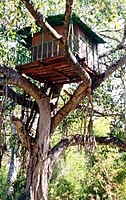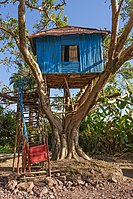
A geodesic dome is a hemispherical thin-shell structure (lattice-shell) based on a geodesic polyhedron. The rigid triangular elements of the dome distribute stress throughout the structure, making geodesic domes able to withstand very heavy loads for their size.

Scaffolding, also called scaffold or staging, is a temporary structure used to support a work crew and materials to aid in the construction, maintenance and repair of buildings, bridges and all other human-made structures. Scaffolds are widely used on site to get access to heights and areas that would be otherwise hard to get to. Unsafe scaffolding has the potential to result in death or serious injury. Scaffolding is also used in adapted forms for formwork and shoring, grandstand seating, concert stages, access/viewing towers, exhibition stands, ski ramps, half pipes and art projects.

The Korowai, also called the Kolufo, are the people who live in southeastern Papua in the Indonesian provinces of South Papua and Highland Papua. Specifically their tribal area is split by the borders of Boven Digoel Regency, Mappi Regency, Asmat Regency, and Yahukimo Regency. They number about 4000 to 4400 people.

A rivet is a permanent mechanical fastener. Before being installed, a rivet consists of a smooth cylindrical shaft with a head on one end. The end opposite the head is called the tail. On installation, the deformed end is called the shop head or buck-tail.

In engineering, a foundation is the element of a structure which connects it to the ground or more rarely, water, transferring loads from the structure to the ground. Foundations are generally considered either shallow or deep. Foundation engineering is the application of soil mechanics and rock mechanics in the design of foundation elements of structures.
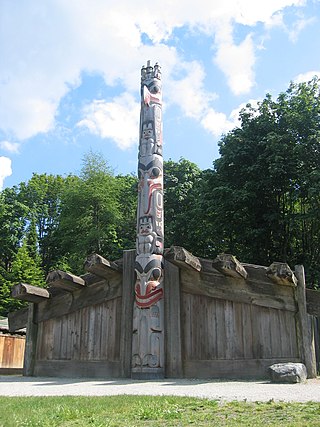
A longhouse or long house is a type of long, proportionately narrow, single-room building for communal dwelling. It has been built in various parts of the world including Asia, Europe, and North America.

A log house, or log building, is a structure built with horizontal logs interlocked at the corners by notching. Logs may be round, squared or hewn to other shapes, either handcrafted or milled. The term "log cabin" generally refers to a smaller, more rustic log house, such as a hunting cabin in the woods, that may or may not have electricity or plumbing.

A treenail, also trenail, trennel, or trunnel, is a wooden peg, pin, or dowel used to fasten pieces of wood together, especially in timber frames, covered bridges, wooden shipbuilding and boat building. It is driven into a hole bored through two pieces of structural wood.

Treetops Hotel was a hotel in Aberdare National Park in Kenya ten miles (16 km) from the township of Nyeri, 1,966 metres (6,450 ft) above sea level on the Aberdare Range and in sight of Mount Kenya. First opened in November 1932 by Eric Sherbrooke Walker, it was built into the tops of the trees of Aberdare National Park as a treehouse, offering the guests a close view of the local wildlife. The idea was to provide a machan experience in relative safety and comfort. From the original modest two-room tree house built into the top of a tree, it grew into a 35-room hotel. The original structure was replaced by a larger structure, also in the tree, but additionally supported on legs; this was burnt down by the Kenya Land and Freedom Army (KLFA) during the 1954 Mau Mau Uprising. The hotel was rebuilt near the same waterhole and became fashionable for wealthy clientele. It included an observation lounges and ground-level photographic hides from which guests could observe the local wildlife at the nearby waterholes. The hotel closed in October 2021.
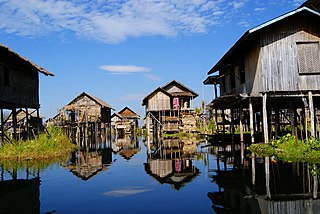
Stilt houses are houses raised on stilts over the surface of the soil or a body of water. Stilt houses are built primarily as a protection against flooding; they also keep out vermin. The shady space under the house can be used for work or storage. Stilt houses are commonly found in Southeast Asia, Oceania, Central America, Caribbean, northern parts of South America, Madagascar, Mauritius, Seychelles and the Maldives.

Framing, in construction, is the fitting together of pieces to give a structure support and shape. Framing materials are usually wood, engineered wood, or structural steel. The alternative to framed construction is generally called mass wall construction, where horizontal layers of stacked materials such as log building, masonry, rammed earth, adobe, etc. are used without framing.

A plate or wall plate is a horizontal, structural, load-bearing member in wooden building framing.

The architecture of Thailand is a major part of the country's cultural legacy and reflects both the challenges of living in Thailand's sometimes extreme climate as well as, historically, the importance of architecture to the Thai people's sense of community and religious beliefs. Influenced by the architectural traditions of many of Thailand's neighbors, it has also developed significant regional variation within its vernacular and religious buildings. Although Siam urged to identify themselves as a modernized state, Western culture and influence was undesirable and inevitable. In an attempt to become distinguished, Thailand's ruling elite gravitated toward selective Modernization to avoid the undesired Western influence.

Pole framing or post-frame construction is a simplified building technique that is an alternative to the labor-intensive traditional timber framing technique. It uses large poles or posts buried in the ground or on a foundation to provide the vertical structural support, along with girts to provide horizontal support. The method was developed and matured during the 1930s as agricultural practices changed, including the shift toward engine-powered farm equipment and the demand for cheaper, larger barns and storage areas.

Out 'N' About is a southern Oregon company that operates treehouse bed and breakfasts and assists with the construction of treehouses. It is located out and about 10 miles (16 km) Southeast of Cave Junction, Oregon,
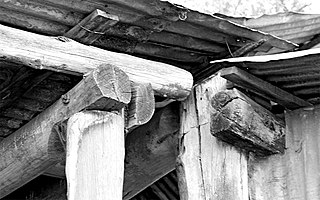
Bush carpentry is an expression used in Australia and New Zealand that refers to improvised methods of building or repair, using available materials and an ad hoc design, usually in a pioneering or rural context.
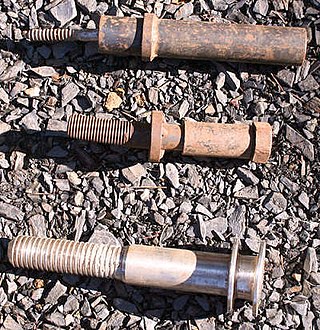
Treehouse attachment bolts or TABs are specialized bolts engineered for treehouse construction. Various models and trademarks exist, with names such as Garnier limbs (GLs); tree anchor bolts; artificial limbs; heavy limbs or hyper limbs (HLs); special tree fastener or stud tree fastener (STFs).
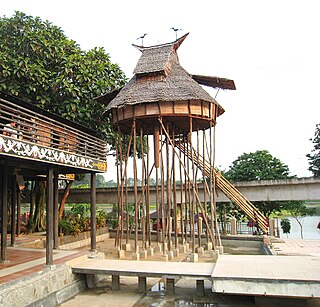
Stilts are poles, posts or pillars used to allow a structure or building to stand at a distance above the ground or water. In flood plains, and on beaches or unstable ground, buildings are often constructed on stilts to protect them from damage by water, waves or shifting soil or sand. As these issues were commonly faced by many societies around the world, stilts have become synonymous with various places and cultures, particularly in South East Asia and Venice.
Horace Burgess's Treehouse was a treehouse and church in Crossville, Tennessee, United States. Construction began in 1993, mostly by Burgess, who says that, in a vision, God commanded him to build a treehouse. It became a popular local attraction and was unofficially called the largest tree house in the world. It was closed by the state on August 30, 2012, for fire code violations. On October 22, 2019, the tree house completely burned to the ground in less than 15 minutes under unknown circumstances.
A Dai bamboo house is a type of stilt building primarily constructed of bamboo as the traditional form of housing for Dai people. The lower floor was about seven or eight feet high. Horses and oxen were hitched to the posts. There was a terrace near the upper stairs, which turned into a large long room. The rest of the house was a largely open space with a low roof, sloping on both sides, with eaves to the floor and, generally, no windows. If the eaves were slightly higher, there were small windows on both sides and a door on the back. In the middle of the building was a fireplace, burning day and night. The roof was covered with thatch and the doors and windows are made of bamboo. The construction is easy. It only took a few days to cut down bamboo and gather neighbors together to build it. These houses are perishable and had to be repaired each year after the rainy season. This construction method was conducive to damp roof, and drainage of rain suitable for topography of the PingBa area.







